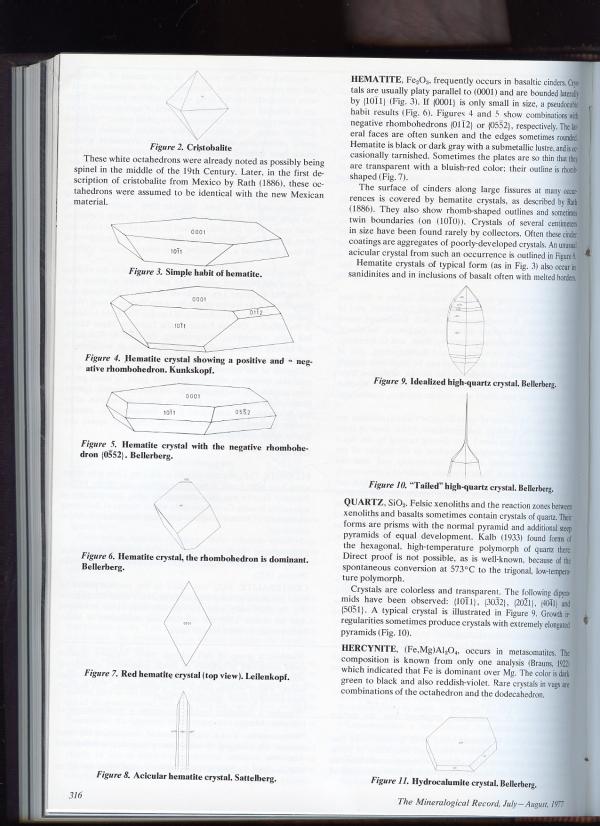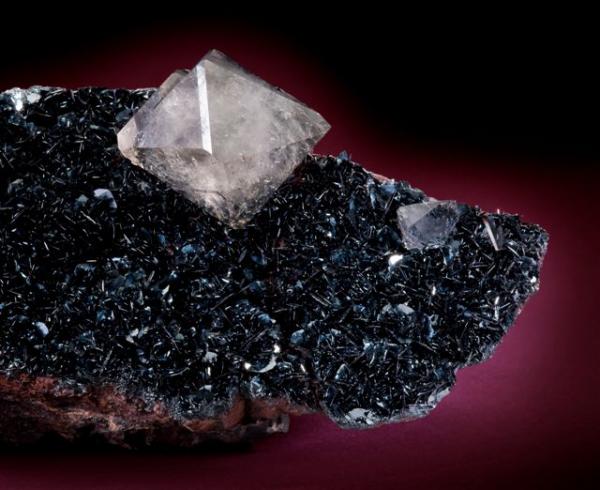| View previous topic :: View next topic |
| Author |
Message |
Carles Curto

Joined: 14 Sep 2006
Posts: 160
Location: Barcelona



|
 Posted: Sep 04, 2008 06:49 Post subject: Re: More about beta Quartz Posted: Sep 04, 2008 06:49 Post subject: Re: More about beta Quartz |
|
|
| The absence (or almost) of prism faces is not definitive to define Quartz-beta. Neat dipyramidal quartzes are common, for example, in Keuper (Triassic) layers, where, even considering possible genetic relations with the intrussion of ofites, to explain high temperature conditions would be complicate and very doubtful.
|
|
| Back to top |
|
 |
Tracy

Joined: 15 Sep 2006
Posts: 551
Location: Toronto



|
 Posted: Sep 04, 2008 08:32 Post subject: Re: More about beta Quartz Posted: Sep 04, 2008 08:32 Post subject: Re: More about beta Quartz |
|
|
I have a quartz-hematite combo from Guangdong which is described on the label as "alpha quartz after beta quartz." This is not scientifically correct, nor does it go so far as to refer to the quartz as a paramorph (as in the webpage we have seen), and I am interpreting it in a descriptive sense only - that is to say, "here is alpha quartz that has a form similar to beta quartz even though it is alpha." Clearly, though, this type of labeling is dangerous and misleading for the uninformed quartz collector who might not benefit from following this thread (I confess that the label to which I refer sounded much more "exotic" until this topic was posted)...
_________________
"Wisdom begins in wonder" - Socrates |
|
| Back to top |
|
 |
nitana2000
Joined: 03 May 2008
Posts: 52
Location: Linares


|
 Posted: Sep 05, 2008 00:31 Post subject: Re: More about beta Quartz Posted: Sep 05, 2008 00:31 Post subject: Re: More about beta Quartz |
|
|
Hello to all, I have news for Mr. Kloprogge:
"Hi Juan,
Thanks for your email. Unfortunately this is a mistake on my website that I haven't been able to correct due to long-term illness., it is correct in the text section but not on the photos page. They are actually alpha-quartz pseudomorph after beta-quartz. When alpha-quartz is heated above 573 degrees C it changes to its polymorph beta, when cooled below 573 degrees it changes back to alpha-quartz again. Therefore it is impossible to find beta-quartz, but only alpha-quartz pseudomorphs after beta-quartz.
I hope this answers your question
Cheers
Theo."
Thank you very much Mr. Kloprogge for your answer. I wish you the best and a fast recovery of your illness.
I translate your email to the forum.
Thank you again. Thank you very much. Best regards. Juan Laureano.
|
|
| Back to top |
|
 |
John S. White
Site Admin

Joined: 04 Sep 2006
Posts: 1298
Location: Stewartstown, Pennsylvania, USA



|
 Posted: Sep 05, 2008 05:28 Post subject: Re: More about beta Quartz Posted: Sep 05, 2008 05:28 Post subject: Re: More about beta Quartz |
|
|
Technically the structural adjustments brought about by temperature changes are called paramorphs, not pseudomorphs. One can possess quartz crystals that are morphologically beta quartz, but they are structurally low or alpha quartz, and these have to have come from an environment that experienced extremely high temperatures, generally acid volcanic conditions.
Pseudomorphism implies the replacement, partially or totally, of the original crystal with something else. In the case of goethite after pyrite, the sulfur in pyrite has been replaced by hydrogen and oxygen.
And, as Carles pointed out, the absence of prism faces does not make a crystal a beta quartz crystal. Many low quartz crystals occur without prism faces, those from Cumbria, England, and Dalnegorsk, Russia, being good examples.
_________________
John S. White
aka Rondinaire |
|
| Back to top |
|
 |
John S. White
Site Admin

Joined: 04 Sep 2006
Posts: 1298
Location: Stewartstown, Pennsylvania, USA



|
 Posted: Sep 22, 2008 06:57 Post subject: Re: More about beta Quartz Posted: Sep 22, 2008 06:57 Post subject: Re: More about beta Quartz |
|
|
As long as we are looking into the subject of beta quartz, I would like to share something with visitors to this site, something I was reminded of by my good friend Saul Krotki. Somehow he remembered an article that appeared in Mineralogical Record back in 1977, in volume 8, pp. 313-326, an article about some minerals from Laacher See, Germany, which are volcanic in origin.
All along in this thread we have been referring to "typical" beta quartzes as consisting of two pyramids attached base to base, formng a hexagonal dipyramid. Cumberland habit quartzes (alpha or low quartz) mimic this habit but are not identical to it because they consist of two rhombohedrons, positive and negative, which share a common central axis. Simple dipyramids, however, are not always the habit displayed by beta quartzes, as is well illustrated by the two drawings from p. 316 of the article, reproduced here. Wouldn't you love to have one of the "tailed" high quartz crystals as seen in Fig. 10?
Bellerberg, by the way, is one of the many quarries in the Laacher See area.
| Description: |
|
| Viewed: |
75464 Time(s) |

|
_________________
John S. White
aka Rondinaire |
|
| Back to top |
|
 |
John S. White
Site Admin

Joined: 04 Sep 2006
Posts: 1298
Location: Stewartstown, Pennsylvania, USA



|
 Posted: Jan 05, 2009 09:21 Post subject: Re: More about beta Quartz Posted: Jan 05, 2009 09:21 Post subject: Re: More about beta Quartz |
|
|
This is a classic Cumberland habit quartz, which mimics the shape of beta quartz crystals, but it is indeed alpha or low temperature quartz. A close inspection will reveal that alternate pyramid faces are not the same size and this is also true of the corresponding narrow prism faces, characteristics that definitely deny this being a beta quartz crystal.
Rob Lavinsky photo
| Description: |
|
| Viewed: |
23631 Time(s) |

|
_________________
John S. White
aka Rondinaire |
|
| Back to top |
|
 |
Aymeric
Joined: 20 Feb 2009
Posts: 32
Location: Between France & Pakistan


|
 Posted: Feb 20, 2009 05:07 Post subject: Re: More about beta Quartz Posted: Feb 20, 2009 05:07 Post subject: Re: More about beta Quartz |
|
|
My, I thought I had a nice Czech Béta Quartz specimen until I read this thread.
Was I wrong ?
| Description: |
| Amethystine Quartz & Limonite - Studenec, Czech Republic |
|
| Viewed: |
23693 Time(s) |

|
|
|
| Back to top |
|
 |
John S. White
Site Admin

Joined: 04 Sep 2006
Posts: 1298
Location: Stewartstown, Pennsylvania, USA



|
 Posted: Feb 20, 2009 06:13 Post subject: Re: More about beta Quartz Posted: Feb 20, 2009 06:13 Post subject: Re: More about beta Quartz |
|
|
Sorry to say it appears that you are wrong. What you appear to have is a very nice Cumberland habit quartz from the Czech Republic.
Welcome to the Forum, we are very pleased to have you join us.
_________________
John S. White
aka Rondinaire |
|
| Back to top |
|
 |
Pete Richards
Site Admin

Joined: 29 Dec 2008
Posts: 846
Location: Northeast Ohio



|
 Posted: Feb 20, 2009 10:12 Post subject: Re: More about beta Quartz Posted: Feb 20, 2009 10:12 Post subject: Re: More about beta Quartz |
|
|
Quartz very similar to the Cumberland specimen posted by John White is also found, again on hematite, at Chub Lake, New York. Similar crystals, without the hematite, are found in ironstone concretions in the Huron River valley in northern Ohio. In both cases these are alpha quartz.
Actually, even beta quartz is not beta quartz. Beta quartz only exists at high temperatures (above about 570°C). Below that temperature, the structure shifts slightly to that of alpha quartz, so crystals that started out as beta quartz become complex intergrowths of alpha quartz domains that are twinned relative to each other according to the Dauphiné twin law. The transformation is a very easy one, since it does not require breaking any chemical bonds, and thus it takes place quickly and reliably once the appropriate temperature is reached.
The believable "beta" quartz examples I have seen are frosted on the crystal faces and translucent. Apparently beta quartz most commonly grows as crystals within a lava - phenocrysts - although it sometimes grows in cavities in rhyolites as well.
_________________
Collecting and studying crystals with interesting habits, twinning, and epitaxy |
|
| Back to top |
|
 |
Aymeric
Joined: 20 Feb 2009
Posts: 32
Location: Between France & Pakistan


|
 Posted: Feb 21, 2009 06:14 Post subject: Re: More about beta Quartz Posted: Feb 21, 2009 06:14 Post subject: Re: More about beta Quartz |
|
|
| No need to be sorry John, I might be wrong, but at least I've learned something ! now I know what a Cumberland habit is, thank you !
|
|
| Back to top |
|
 |
marco campos-venuti

Joined: 09 Apr 2014
Posts: 234
Location: Sevilla



|
 Posted: Mar 08, 2016 06:48 Post subject: Re: More about beta Quartz Posted: Mar 08, 2016 06:48 Post subject: Re: More about beta Quartz |
|
|
Hi all, nice theme!
This is a specimen of the "Porfido granodioritico" from Elba Island, Italy. It is a magmatic body of granodiorite characterized by big phenocrystals of orthoclase (not in this sample) and phenocrystals of quartz, associated to the main body of the Monte Capanne pluton, famous for its pegmatites with elbaites.
In the specimens the quartz crystals are partially freed from its magmatic matrix due to wind erosion.
If I understand well, this can be a beta quartz (alpha pseudo after beta). The symmetry is strictly hexagonal, but the prism is present.
| Mineral: | Alpha Quartz pseudo after Beta Quartz in granodiorite matrix |
| Locality: | | Capo di Fonza, Elba Island, Livorno Province, Tuscany, Italy |  |
|
| Dimensions: | specimen 14 cm, crystals about 1 cm |
| Description: |
|
| Viewed: |
19197 Time(s) |

|
|
|
| Back to top |
|
 |
John S. White
Site Admin

Joined: 04 Sep 2006
Posts: 1298
Location: Stewartstown, Pennsylvania, USA



|
 Posted: Mar 08, 2016 07:14 Post subject: Re: More about beta Quartz Posted: Mar 08, 2016 07:14 Post subject: Re: More about beta Quartz |
|
|
Beta quartz crystals can exhibit prisms, no problem. Your crystals do appear to be pseudomorphs after beta quartz.
_________________
John S. White
aka Rondinaire |
|
| Back to top |
|
 |
Pete Modreski
Site Admin

Joined: 30 Jul 2007
Posts: 710
Location: Denver, Colorado



|
 Posted: Mar 08, 2016 12:34 Post subject: Re: More about beta Quartz Posted: Mar 08, 2016 12:34 Post subject: Re: More about beta Quartz |
|
|
Thank you for showing us this particularly good specimen, Marco. It's very unusual to see the beta quartz* crystals well exposed on the matrix this way!
*and we all will understand, of course, that if I write "beta quartz" for brevity, I really mean "alpha quartz paramorphs after beta quartz".
|
|
| Back to top |
|
 |
|




